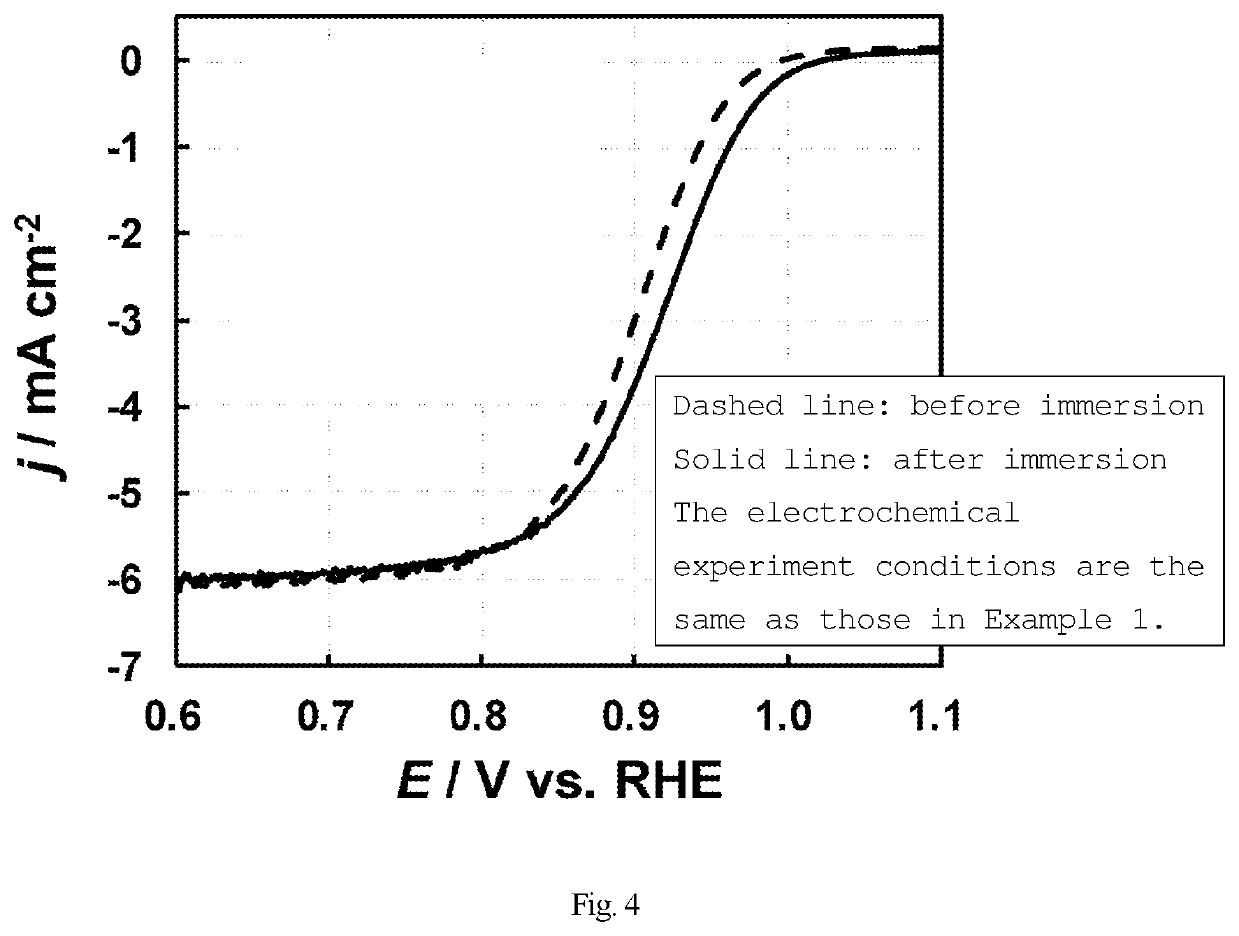Electrochemical oxygen reduction catalyst
a technology of oxygen reduction catalyst and electrochemical oxygen, which is applied in the direction of organic compound/hydride/coordination complex catalyst, physical/chemical process catalyst, cell component, etc., can solve the problems of increasing the amount of platinum and the activity is still not sufficient, and achieves low overvoltage, suppress the effect of the reduction, and high oxygen reduction activity
- Summary
- Abstract
- Description
- Claims
- Application Information
AI Technical Summary
Benefits of technology
Problems solved by technology
Method used
Image
Examples
example 1
f Increase in Oxygen Reduction Activity of Platinum Catalyst by Melamine (Immersion)
[0121]A platinum catalyst (5 mg) (produced by Tanaka Kikinzoku Kogyo, TEC10E50E, average particle size: 2 to 3 nm) was suspended in a mixed solvent of ultrapure water (5.14 mL) and 2-propanol (1.62 mL). The suspension (3.6 μL) was added dropwise to a glassy carbon electrode (surface area: 0.0707 cm2) produced by BAS Inc., followed by drying.
[0122]Using the three-electrode method, specifically, using the catalyst modified electrode as a working electrode, a reversible hydrogen electrode as a reference electrode, and a platinum coil as a counter-electrode, an electrochemical measurement was performed. As an electrolyte, a 0.1M perchloric acid aqueous solution was used. First, cyclic voltammetry was performed under argon atmosphere, and then a gas atmosphere was changed to oxygen to perform linear sweep voltammetry from the low-potential side. Thus, the oxygen reduction activity obtained when the cataly...
example 2
f Increase in Oxygen Reduction Activity and Durability of Platinum Catalyst by Melamine Resin (Drying After Adding Dropwise)
[0125]A platinum catalyst (5 mg) (produced by Tanaka Kikinzoku Kogyo, TEC10E50E, average particle size: 2.5 nm) was suspended in a mixed solvent of ultrapure water (5.14 mL) and 2-propanol (1.62 mL). The suspension (3.6 μL) was added dropwise to a glassy carbon electrode (surface area: 0.0707 cm2) produced by BAS Inc., and dried.
[0126]Using the three-electrode method, specifically, using the catalyst modified electrode as a working electrode, a reversible hydrogen electrode as a reference electrode, and a platinum coil as a counter-electrode, an electrochemical measurement was performed. As an electrolyte, a 0.1M perchloric acid aqueous solution was used. First, cyclic voltammetry was performed under argon atmosphere, and then a gas atmosphere was changed to oxygen to perform linear sweep voltammetry from the low-potential side. Thus, the oxygen reduction activ...
example 3
f Increase in Oxygen Reduction Activity of Platinum Catalyst by Diaminodiethylamino-1,3,5-Triazine (Immersion)
[0134]A catalyst was produced in the same manner as in Example 1, except that an acetone solution (3 mM) of diaminodiethylamino-1,3,5-triazine was used in place of the melamine aqueous solution, and evaluated.
[0135]FIG. 4 is a linear sweep voltammogram under oxygen atmosphere. By immersing the electrode in the acetone solution of diaminodiethylamino-1,3,5-triazine so that diaminodiethylamino-1,3,5-triazine was adsorbed (supported) on platinum, the reduction current (−j) in the high-potential region above 0.9 V was increased. This indicated that by immersing the electrode in the acetone solution of diaminodiethylamino-1,3,5-triazine so that diaminodiethylamino-1,3,5-triazine was adsorbed (supported) on platinum, the oxygen reduction activity was increased and the overvoltage was reduced, thus reducing the amount of platinum used. The coverage of the diaminodiethylamino-1,3,5-...
PUM
| Property | Measurement | Unit |
|---|---|---|
| particle size | aaaaa | aaaaa |
| particle size | aaaaa | aaaaa |
| particle size | aaaaa | aaaaa |
Abstract
Description
Claims
Application Information
 Login to View More
Login to View More - R&D
- Intellectual Property
- Life Sciences
- Materials
- Tech Scout
- Unparalleled Data Quality
- Higher Quality Content
- 60% Fewer Hallucinations
Browse by: Latest US Patents, China's latest patents, Technical Efficacy Thesaurus, Application Domain, Technology Topic, Popular Technical Reports.
© 2025 PatSnap. All rights reserved.Legal|Privacy policy|Modern Slavery Act Transparency Statement|Sitemap|About US| Contact US: help@patsnap.com



